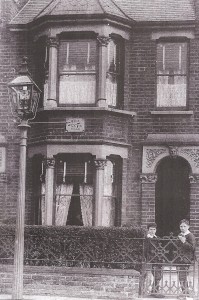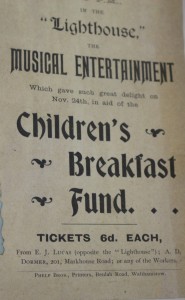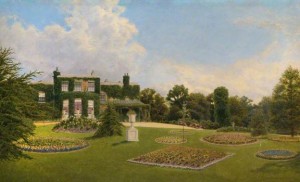Music and performance in the late nineteenth century
In Victorian Walthamstow, the first public concerts began to be held, first in church halls, and then in the grand Victoria Hall built by J F H Read – a prosperous resident who stayed on, helping the town as philanthropist, musician and promoter of many good causes.
There is information on the panels and elsewhere on this website about Walthamstow’s rapid transformation from village to commuter town to urban area over just a few decades.
To download this teachers resource along with a suggested activity please click the link below:
Victorian-and-Edwardian-Walthamstow-teachers-resource.pdf
As it grew, Walthamstow changed in character. Many of the comfortably-off families who had lived in the area in the 1860s began to move further out of London, often making a handsome profit by selling their substantial gardens and orchards for development. Many local Victorian houses have one or two very old fruit trees or even a magnolia in their garden, survivals of past grandeur.
Click to read the panel ‘Walthamstow Transformed’
 But there was also more investment, in everything from churches to factories to schools. Education for all children was now compulsory, and free, and that education included music as well as the Three Rs. In Walthamstow as elsewhere, the newly literate wanted more, and better, education for themselves and their children.
But there was also more investment, in everything from churches to factories to schools. Education for all children was now compulsory, and free, and that education included music as well as the Three Rs. In Walthamstow as elsewhere, the newly literate wanted more, and better, education for themselves and their children.
Click here to read the panel ‘Our Town’
 The first public concerts began to be held, first in church halls, and then in the grand Victoria Hall built by J F H Read – a prosperous resident who stayed on, helping the town as philanthropist, musician and promoter of many good causes.
The first public concerts began to be held, first in church halls, and then in the grand Victoria Hall built by J F H Read – a prosperous resident who stayed on, helping the town as philanthropist, musician and promoter of many good causes.
Click here for more information about JFH Read and the house he lived in – The Chestnuts
At this time the only official safety net for those who fell on hard times was the workhouse. But there was also a network of local charities, providing everything from medicine to layettes for new babies to fuel to evening classes, with money raised by special events of all kinds as well as direct donations. . And increasingly those in need themselves became involved in raising the money needed.
Click here to see the information panel ‘Music for Charity’
It was very common for local schools and churches to organise boot clubs. At a time when many children missed school because their families could not afford to buy them footwear, parents who could would pay a subscription to spread the cost of shoes. And for those who could not, the community would get together to find ways and means.
Click here to see the information panel ‘Music for All’
Music Resources
19th-Century-songs-for-amateur-and-professional-permformance.pdf
